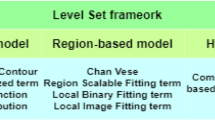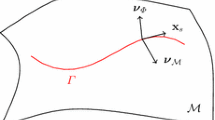Abstract
In the last years, deformable models raised much interest and found various applications in the field of 2D and 3D computer vision. Active surfaces are usually employed for segmentation and object reconstruction. In this paper, a new model for 3D image segmentation is proposed, the Topological Active Volumes (TAV). This model is based on deformable models, it is able to integrate the most representative characteristics of the region-based and boundary-based segmentation models and it also provides information about the topological properties of the inside of detected objects. This model has the ability to perform topological local changes in its structure during the adjustment phase in order to: obtain a specific adjustment to object’s local singularities, find several objects in the scene and identify and delimit holes in detected structures.
Access this chapter
Tax calculation will be finalised at checkout
Purchases are for personal use only
Preview
Unable to display preview. Download preview PDF.
Similar content being viewed by others
References
Kass, M., Witkin, A., Terzopoulos, D.: Active contour models. International Journal of Computer Vision 1(2), 321–323 (1988)
Terzopoulos, D., Witkin, A., Kass, M.: Constraints on deformable models: Recovering 3D shape and nonrigid motion. Artificial Intelligence 36(1), 91–123 (1988)
Ferrant, M., et al.: Surface based atlas matching of the brain using deformable surfaces and volumetric finite elements. In: Niessen, W.J., Viergever, M.A. (eds.) MICCAI 2001. LNCS, vol. 2208, p. 1352. Springer, Heidelberg (2001)
Zhukov, L., Guskov, I., Bao, J., Wood, J., Breen, D.: Dynamic deformable models for mri heart segmentation. In: SPIE Medical Imaging 2002 (2002)
Montagnat, J., Delingette, H.: Globally constrained deformable models for 3d object reconstruction. Signal Processing 71(2), 173–186 (1998)
Starck, J., Hilton, A., Illingworth, J.: Reconstruction of animated models from images using constrained deformable surfaces. In: Braquelaire, A., Lachaud, J.-O., Vialard, A. (eds.) DGCI 2002. LNCS, vol. 2301, pp. 382–391. Springer, Heidelberg (2002)
Magee, D., Bulpitt, A., Berry, E.: Combining 3d deformable models and level set methods for the segmentation of abdominal aortic aneurysms. In: Proc. of the British Machine Vision Conference (2001)
Paragios, N., Deriche, R.: Geodesic active contours and level sets for the detection and tracking of moving objects. IEEE Transactions on Pattern Analysis and Machine Intelligence 22(3), 266–280 (2000)
Ansia, F.M., Penedo, M.G., Mariño, C., Mosquera, A.: A new approach to active nets. Pattern Recognition and Image Analysis 2, 76–77 (1999)
Foley, J.D., van Dam, A., Feiner, S.K., Hughes, J.F.: Computer Graphics: Principles and Practice in C, 2/E, pp. 74–81. Addison Wesley Professional, Reading (1996)
Ehrenfeld, S., Littauer, S.B.: Introduction to Statistical Method, p. 132. McGraw-Hill, New York (1964)
Canny, J.: A computational approach to edge-detection. IEEE Trans. on Pattern Analysis and Machine Intelligence 8(6), 679–698 (1986)
Author information
Authors and Affiliations
Editor information
Editors and Affiliations
Rights and permissions
Copyright information
© 2003 Springer-Verlag Berlin Heidelberg
About this paper
Cite this paper
Barreira, N., Penedo, M.G., Mariño, C., Ansia, F.M. (2003). Topological Active Volumes. In: Petkov, N., Westenberg, M.A. (eds) Computer Analysis of Images and Patterns. CAIP 2003. Lecture Notes in Computer Science, vol 2756. Springer, Berlin, Heidelberg. https://doi.org/10.1007/978-3-540-45179-2_42
Download citation
DOI: https://doi.org/10.1007/978-3-540-45179-2_42
Publisher Name: Springer, Berlin, Heidelberg
Print ISBN: 978-3-540-40730-0
Online ISBN: 978-3-540-45179-2
eBook Packages: Springer Book Archive




